A summer of berries on The Food Farm
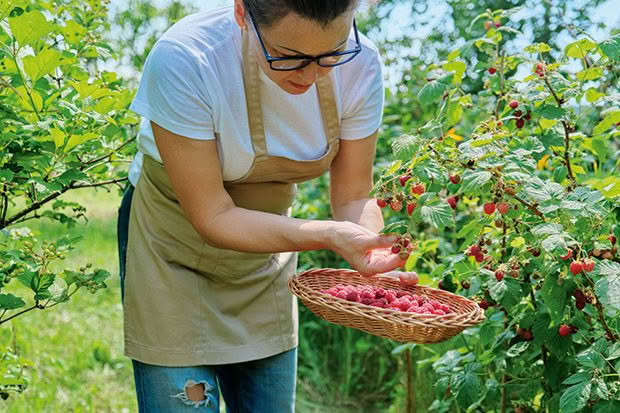
It just wouldn’t be Christmas on The Food Farm without fresh berries adorning the desserts on the table.
Words and photos: Angela Clifford
In my moments of daydreaming on The Food Farm, I sometimes entertain fanciful notions of growing subtropical fruit. Some bananas, avocados and mango trees in my food forest would be lovely, or maybe a sapote or two.
A pineapple with actual flavour and its spiky top still attached would be wonderful. The reality is these plants don’t do well in North Canterbury. But in December, it’s not hard to bring my attention and gratitude back to the intense and exquisite fruits that thrive here in easy abundance: berries.
Berries play a major role in our growing system here on The Food Farm and at no time are they more cherished than Christmas. It’s become a tradition in our household to pick the berries on Christmas morning.
Their beautiful shapes and colours feel very festive, and they’re always a winning addition to any Christmas feast. It really doesn’t feel like a New Zealand Christmas without summer berries on desserts like pavlova.
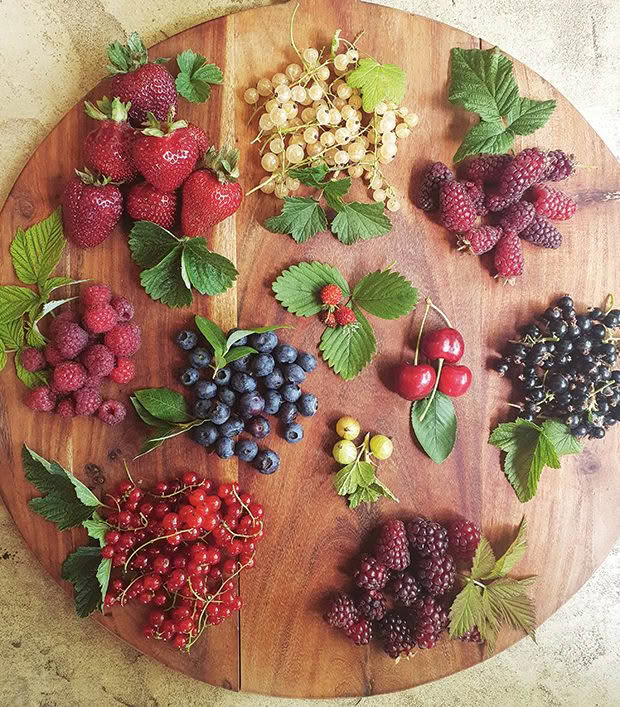
Our favourites are the raspberries. Growing our own means we don’t have to buy the expensive ones that have been sitting in plastic containers on supermarket shelves for days. And although December in North Canterbury can still throw some inclement weather at us, raspberries tend to be more robust than other berries and hold up quite well.
Our other go-to Christmas berries are currants. They feel like an old-fashioned offering and their jewel-like appearance makes them very appealing. We grow a large row of blackcurrants, but it’s the red and white currants that I love so much at Christmas time. Their brighter tones act as a perfect foil to the darker red berries and they really do look like a string of baubles.
Their tart, tannic flavour and texture perfectly complements sweet desserts and the richness of cream.
Currants are attractive plants and grow well when you underplant them with shade-lovers and put them below canopy trees, making them the perfect food forest specimen.
You can sometimes get away with not netting them, as they hide their berries well. If the birds find them, however, be prepared to wake up to a plant stripped of its fruit.
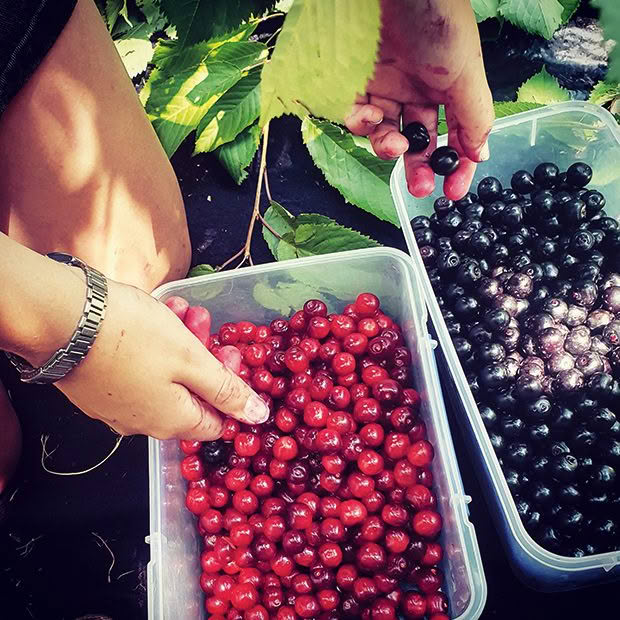
We also grow boysenberries and loganberries, both of which are ready in time for Christmas. They keep slowly ripening over the next couple of months, allowing anyone who wanders around our food forest or berry house to grab a handful for a snack. Compared to raspberries, they have a different flavour, less acidity, darker fruit and not such a confectionery sweetness.
We also grow blueberries and they’re so much more flavourful and intense than store-bought ones. Like boysenberries and loganberries they’ll ripen over a long period of time, and their crunchier texture is lovely alongside the softness of other berries.
For some reason, I’ve noticed there are far more blueberries than raspberries or boysenberries on supermarket shelves at this time of year. Perhaps it’s because the thicker skin of blueberries makes them more likely to handle freighting and handling, and they last longer once picked. And yet, as much as I love a good blueberry, they’re not as magical at Christmas time as softer cousins such as raspberries and boysenberries.
If we’re lucky, the first cherries – usually the cultivar ‘Stella’ – are ready around Christmas time as well. Even if it’s just a handful of the earliest berries, they’re a wonderful addition to the top of the pavlova wreath.
I’ve never been able to get alpine strawberries to naturalise here, but I’ve noticed a few tiny ones hiding in random places at this time of year. I love the foliage of this plant, which I use as a garnish for a berry desserts.
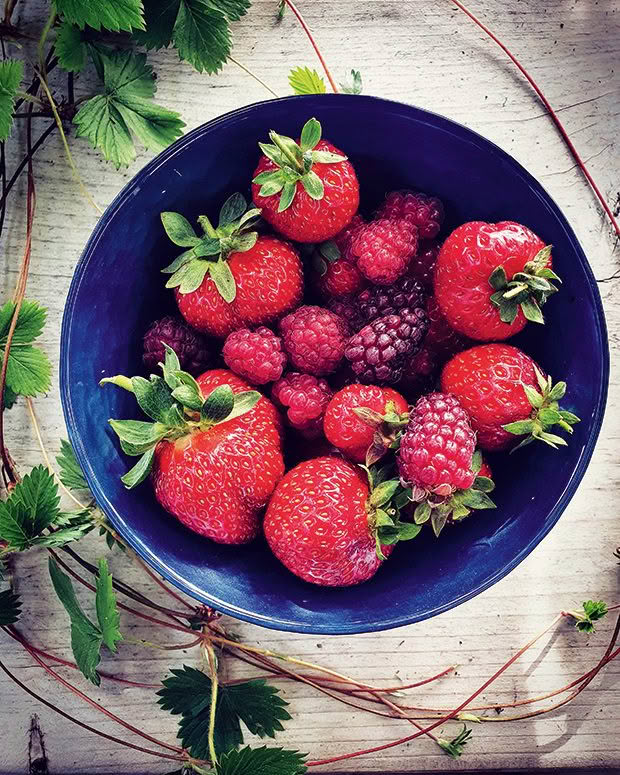
Whatever berries end up atop your pavlova this Christmas, they’re bound to be well-recieved. There’s something incredibly special about having your home-grown berries as the jewels in the dessert crown on this most important food day.
My mother makes the best meringues in the world. They turn out chewy and caramelised, and we’ve concluded this is because she starts the oven at a slightly higher temperature and turns it down when they go in.
She also doesn’t add vanilla to her meringues; adding vanilla or sugar to the cream is a big no-no in my family. Every family has their own meringue recipe and however you make yours I’m sure it will be delicious. Ultimately, the meringue and cream are just a vehicle for the stars of the show – your home-grown, freshly picked berries.
WILD CHERRIES
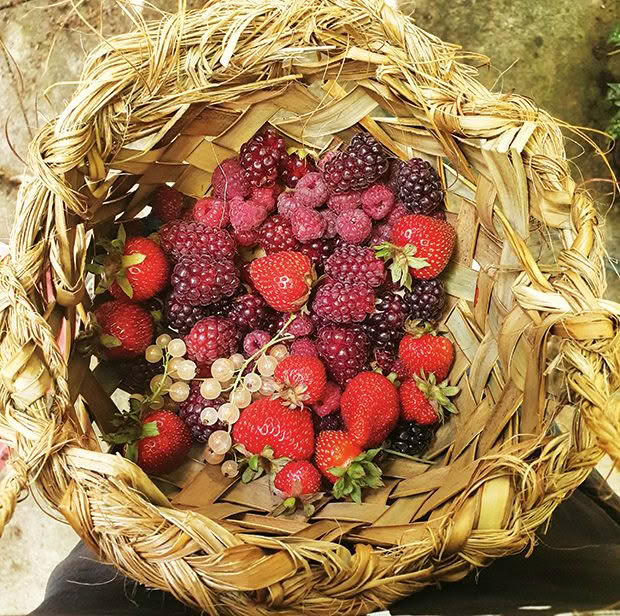
December is the month for wild cherries here in North Canterbury. They are black Siberian cherries; quite small compared to the cultivated types, but just as delicious. We can find them growing wild from Hanmer to Kaikōura. Foraging cherries is a good reason to spend time with friend Nigel Wilson on his Garry River Farm in Mt Thomas, which is the area where the berries are believed to originate from. There seems to be two distinct varieties, one dark red, the other lighter red. As a food community, we’re still figuring out the best thing to do with them, but for the moment, our family likes to gather handfuls and eat them on the way to diving, hunting and fishing adventures.
The Food Farm Meringue Wreath
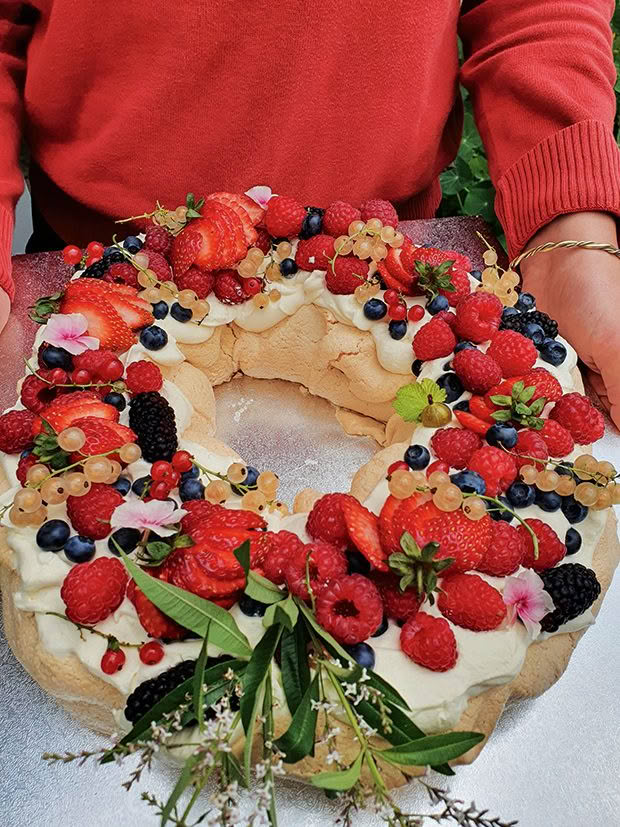
Serves: 8 to 12
Cooking time: 2 hours
INGREDIENTS
6 egg whites
1 ½ cups caster sugar
1 tsp lemon juice
2 cups cream
3 cups mixed fresh berries
Large sprig of lemon verbena or
greenery to garnish
METHOD
Preheat oven to 150˚C (not fan bake).
Draw a 26cm circle on a piece of baking paper. Then inside that draw a 10cm circle. This is the template for your wreath. Turn the baking paper over so the ink doesn’t combine with your meringue. Put the baking paper on a baking tray.
Whisk the egg whites until they’re soft peaks. Continue to whisk, adding the sugar a tablespoon or two at a time, until the sugar is dissolved. The mixture should be thick and glossy at this point. Add the lemon juice and beat for a further minute or two.
Drop heaped tablespoons of the meringue between the two circles, making sure the dollops touch each other to form the wreath. Gently push the top down with the back of the spoon to form indents that the cream will eventually sit in.
Put the meringue in the oven, turning it down to 150˚C as you do. Bake for about 1 ½ hours, and then turn off the oven, leaving the meringue inside to cool completely.
To serve, whip the cream until thick and dollop it over the wreath. Arrange the berries over the top of the cream, ensuring a good spread of different toppings. It doesn’t matter if they spill over the edge; this just adds to the sense of abundance. Finally, top with the sprig of lemon verbena. Serve with a bowl of fresh berries as an accompaniment.
Love this story? Subscribe now!
 This article first appeared in NZ Lifestyle Block Magazine.
This article first appeared in NZ Lifestyle Block Magazine.
